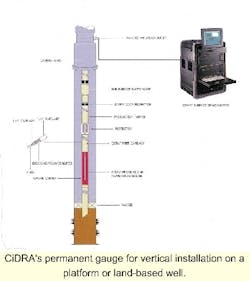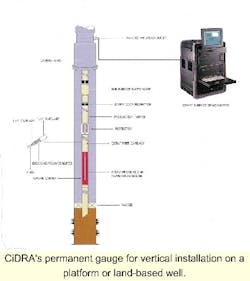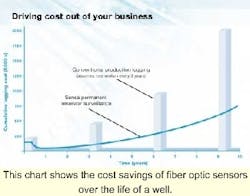COMPLETION TECHNOLOGY: Second-generation fiber optics paving way for reliable permanent sensors
Fiber optic technology is showing up in an increasing number of offshore completions. Driven by the need for more/ better wellbore data and equipment relia-bility, fiber optics may eventually find a way into a wide-range of developments.
Brock Williams, Program Leader for Deepwater Wells at BP, said the reservoir surveillance data retrieved by fiber optic-based systems is critical to maximizing returns. While electronic gauges lowered on wireline can provide the same data, it is only a snapshot.
At the same time, the cost of such intervention is very high in deepwater operations. This is what has led to the development of permanent downhole electronic gauges. Installing these gauges eliminates the need for intervention, but the gauges have proved somewhat unreliable. Williams said advances have been made in the reliability of the electronic gauges, but it is not enough. He said high temperatures downhole increase the likelihood a permanent gauge may fail.
Before an operator is willing to install a permanent downhole gauge, Williams said, the oil and gas producer wants in the neighborhood of 99% reliability over five years. "This is just not in the cards for electronics," he said. While a lot of companies are now looking to fiber optic-based systems, Williams said the first generation of these tools were not necessarily more reliable than their electronic counterparts.
Earlier systems had failure rates as high as the electronic systems, although for other reasons. How-ever, the new generation of these systems holds a lot of promise, Williams said.
New method
BP has been working with CiDRA Optical Sensing Systems on Bragg Grating technology. This process uses two lasers to create a specific disturbance in the glass of an optical fiber. This disturbance is photosensitive to a specific wavelength of light. The area of disturbance will reflect light in this certain wave length, while letting the rest of the spectrum pass through.
An optical fiber is attached to this Bragg Grating sensor and transmits the light down the sensor and provides the path for the reflected light. Pressure alters the effect of the Bragg Grating, so that at different pressures, different frequencies of light are reflected. Williams said his company has plans to install six of these systems in wells this year.
While the technology is now commercialized, it is not suitable for every application. Williams said the Bragg Grating systems currently are more expensive than the downhole electronic gauges, so the industry sees them as an alternative for HT/HP (high temperature-high pressure) environments where electronics are very likely to fail after a couple of years. The fiber optic-based technology is also being used for flow rate, oil/water content, seismic, and temperature profile measurements.
Although BP has embraced this emerging technology, Williams said there are still skeptics in the field. Until there are more of these systems in wells, some people will not believe in their reliability. As more applications are put in place, Williams said the price of systems should come down, putting more in the ground, which will in turn boost confidence and further increase the number of systems installed. "We have a high confidence level," he said.
Beyond building the market, Williams said more installations will give the industry experience in understanding the data these systems produce. Once an operator realizes he has access to continual flow, temperature, and pressure data, he can more effectively manage a reservoir. "Our emphasis in the near term is to rapidly develop our experience with fiber optics through field developments," Williams said.
Reliability
In-well fiber optics sensors offer users the ability to measure temperature, pressure, flow rate, and two-phase fraction of fluids continually in real-time, explains Keith Morley, Senior Vice-President of CiDRA. In the near future the Bragg-Grating based, optical technology should allow the measurement of multiphase flow (water, oil, and gas) and sand content. Also under development is the technology to provide downhole measurement of acoustics (for active and passive seismic data), strain, density, vibration, and chemical constituents.
When an operator installs a permanent downhole gauge, the number one consideration is reliability, Morley said. Downhole information is important throughout the life of the well. To realize maximum value from the gauge, it must remain operational for 5-10 years. Initially, when the well is brought on line, the data is important for managing and maximizing drawdown, obtaining well performance information, and verifying downhole parameters determined during testing.
As the well is produced, a downhole gauge provides the opportunity for using each shut-in, planned or unplanned, as a pressure buildup test to derive parameters such as near-well permeability, well skin, and reservoir boundary information. Later in the life of the well, as it begins to deplete, reliable downhole measurements become critical to reservoir management decisions for the well and field, including positioning of additional producer or injector wells.
Conventional downhole gauges are electronic. Morley said that while there have been advances in the reliability of these systems, in-well electronic components are very sensitive to temperature, vibration, and the type of corrosive conditions that are found in producing wells. As a result, it is common for these gauges to fail early in the life of the well.
Because in-well fiber optic systems contain no downhole electronics and relatively few in-well components, their reliability is greatly enhanced. In addition, Morley said fiber optic sensors are more stable in a higher temperature and pressure environment. Tests of fiber optic pressure transducers at 150° C and 5,000 psi for over two years have demonstrated drift rates of less than 1 psi/year, compared with average electronic gauge published drift rates of up to 5 psi/year.
While fiber optics may now be seen as competing with conventional gauges, Morley said the permanent reservoir monitoring market would have actually benefited from better reliability of electronics in the past. This would have proven to the industry, years ago, the real value of downhole information and accelerated the development of software allowing the incorporation of data into reservoir modeling applications. New, reliable fiber-based products, providing an array of measurements, will give users the data they need and allow the permanent monitoring market to reach its full potential.
The most obvious advantage of fiber optic-based systems, reliability, is apparent in HT/HP situations. Morley said this is the proverbial "foot-in-the-door." Operators are realizing that the fiber optic approach has applications in a broad range of well conditions.
Aside from taking electronics out of the wellbore, fiber optics allows operators to take a much broader range of measurements, many of which were previously only available through logging or other intervention activities.
Interventions are costly, may be dangerous, and result in deferred production. This flexibility fits well with the growing interest in reservoir management. If an operator can monitor how a well, or series of wells, depletes a reservoir, then that company can make informed decisions about how to best manage the asset and get the most oil out of the ground in as short a time as possible, while maximizing total reservoir drainage.
State of the art
Morley said CiDRA has a strategic alliance with BP through which BP provides guidance on value-added applications for in-well fiber optic technology, with a special focus on deepwater field developments. The arrangement is beneficial to CiDRA because it gives the company a customer to try out new products and direct specific research.
BP considers CiDRA's fiber optics a critical technology, according to Morley, and is interested in a whole range of products, from pressure and temperature gauges to multiphase flowmeters, and in-well seismic systems that are currently being developed.
Morley said CiDRA engineers and management meet with BP monthly, and there is a steering committee with representatives of both companies to guide the alliance. Beyond the scope of technology addressed by the alliance, Morley said BP is interested in seeing fiber optics applied to a broader range of well and field types.
While the alliance allows BP to influence fiber optic sensor development and gives CiDRA a product user, Morley said there is no exclusivity commitment to the products or applications that CiDRA develops with BP. He said it is beneficial for BP to have other operators adopt the new technology because it will accelerate the learning curve and encourage the major service companies to adopt fiber optic technology. CiDRA also has received lead customer support from Shell Oil Company and input from other major oil companies in the design and qualification of its systems.
Products
Fiber optic sensing installations include Bragg Grating pressure and temperature gauges and two-phase flowmeters, along with distributed temperature systems, according to Morley. He said the company's Bragg Grating pressure and temperature transducer has a form factor similar to that for a conventional downhole gauge, but there are no in-well electronics.
The system incorporates a multi-well-capable, surface opto-electronics system that is connected by a proprietary 1/4-in. diameter, fiber optic cable system to the in-well sensor system mounted in the tubing string. This makes the total assembly easy for operators to install using existing equipment and techniques.
The systems make highly accurate, discrete measurements at a fixed point in the wellbore. Multiple sensors can be deployed on a single fiber optic cable to give operators discrete, downhole readings at different locations in the wellbore. CiDRA's fiber cable system also incorporates a multimode fiber, which allows operators to obtain a distributed temperature profile (DTS) over the length of the fiber.
Cost/value evaluation
Before fiber optic systems can gain greater penetration in the completions market, they must overcome the perception of high prices. Oliver Laurence, Market Manager Upstream Oil and Gas for Sensa, said there has to be a shift in the way an operator looks at data acquisition.
Because the fiber optics are installed when the well is constructed, they become part of the capital cost. Traditionally, data acquisition, such as well logs, has been considered an operational cost. In the big picture, Laurence said the money spent on a fiber optic system for downhole measurement is less than 1% of the overall capital expenditure on an average well. This is not a major expense when one considers the benefits.
A production log in a horizontal well can cost in the neighborhood of $250,000 to run. Laurence said this expense results in just a snapshot of what is happening downhole. With distributed temperature and pressure monitoring systems, the operator gets real-time data throughout the life of the well. This makes it much easier to spot changing trends in production and see how the reservoir is responding to the chosen depletion strategy.
At the end of the day the drivers for this new technology are simple, Laurence said. Operators can ensure production levels are continuously maximized and reservoir depletion strategies can be continually updated based upon real-time information. This increased production rate and level of recovery quickly cover the added capital expense of the fiber optic system.
Difficult sell
Still, it is a difficult sell. "It requires a paradigm shift," Laurence said, "but those operators who have bought into the system are reaping the benefits already." Permanent downhole electronic gauges have become much more reliable over the last few years, Laurence said, but with all the progress that has been made, they still cannot handle the temperatures and pressure fiber optics can.
With fiber optics technology just coming into its own in the oil field, Laurence said he expects even greater advances in the near future. He describes this technology as being at the very front end of its development. Distributed measurements, such as those taken by Sensa, differ from Bragg Grating technologies that use a grating mask, which is written into the core of the fiber.
Distributed temperature and pressure measurements use the entire length of the optical fiber as a sensing device. For example, to take pressure measurements, a pulse of light is sent down the fiber to measure an air gap designed into the fiber. This gap is very small, about 200 microns, but by measuring the interference patterns between the light signals reflected off of the front end of the gap and the back, the topside equipment can make an accurate pressure measurement of the well.
For distributed temperature measurement, a pulse of light is sent down the fiber and, depending on how long it takes for the back scatter to return to the surface and how strong the reflected signal is, a complete temperature profile of the entire well can be made. A separate fiber is required for each of these capabilities, Laurence said. Distributed temperature fiber optic measurement technology is the most mature in the oil field. Laurence said Sensa has installed more than 130 temperature systems worldwide.
Acoustic systems
Beyond this, Sensa is looking at acoustic measurements, which could "listen in" on the production stream. These sensors would be correlated with temperature and pressure data to give operators a multi-phase flow measurement downhole, Laurence said.
The range of the acoustic fiber optic system allows the same system to be used as a subsurface seismic detection system. This system could also allow detection of sand production. This technology is just finishing Phase I testing, Laurence said, and if work continues to progress, it should soon enter Phase II. His estimates that a commercial product will be available within 18 months.
Laurence said the system has to prove reliable in 20 applications before it is offered commercially. While the sensing technology is in place, Laurence said the packaging has to be designed so that anyone who works on a platform can operate it successfully. There is a difference between a system a designer in the lab can operate and one that will perform successfully in the field. "In the hands of an expert, everything runs smoothly," he said.
As more applications come on line in high-end deepwater fields, Laurence said he expects there to be a split in the technology. While deepwater fields will command the latest developments, there will also be a market for re-entry work and secondary completions. Sensa already has a program to cater to these low-end applications. Rather than selling the operator all of the expensive interpretation equipment, Sensa will install the downhole fiber optics and then take the readings on their own equipment.


